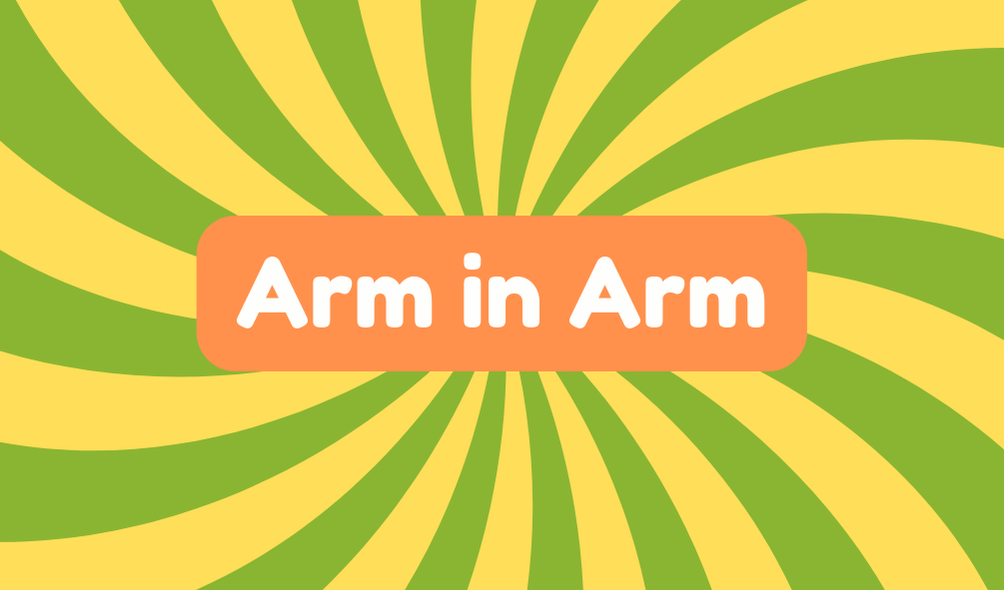"Arm in arm" denotes unity and intimacy, symbolizing a close bond between individuals. Its origin likely traces back to old English, reflecting the importance of physical closeness in relationships. This phrase appears in various contexts, from romantic partnerships to friendships and family ties. Examples include couples walking arm in arm or friends sharing a laugh together. Though it conveys connection, one might question the authenticity behind such displays. There is more to explore regarding its cultural significance and relevance today.
Synonyms
The phrase "arm in arm" evokes a vivid image of unity and connection, and several synonyms express similar notions of closeness and partnership. These alternatives not only signify friendly partnerships but also emphasize emotional connections forged between individuals. However, while they may carry positive connotations, one should scrutinize whether they promote authentic intimacy or mere surface appearances.
- *Side by side*
- *Togetherness*
- *Linking arms*
- *In tandem*
In this modern age, examining the depth of these expressions is essential, as true emotional connections require more than mere physical closeness to truly flourish.
Example of Sentences
Expressions of closeness, such as "walking arm in arm," can be found throughout everyday life, often conveying feelings of unity and partnership. While some view this as a simple display of affection, others might see it as a societal norm. Consider the following examples of public displays of intimate connections:
- The couple strolled arm in arm, showcasing their shared journey.
- Arm in arm, they confronted life's difficulties, illustrating their strength.
- Friends shared laughter, walking arm in arm, emphasizing their bond.
- At the park, parents walked arm in arm, symbolizing family unity.
Such phrases encapsulate deeper meanings in connection and community.
Origin
While the exact origins of the phrase "arm in arm" remain unclear, it is widely thought to be rooted in old English. This expression encapsulates the cultural significance of physical closeness, reflecting historical usage in various social contexts. Remarkably, it signifies both intimacy and unity.
| Context | Usage |
|---|---|
| Romantic | Displays love between partners |
| Familial | Supports family bonds |
| Friendship | Strengthens social ties |
| Political | Represents solidarity |
Such expressions likely evolved from the simple act of intertwining arms, borrowing from real-life experiences that highlight human connection.
Collocations
Building on the historical significance of "arm in arm," its usage extends into various collocations that shed light on the phrase's versatility in language. These expressions often illustrate the emotional nuances tied to affectionate gestures and symbolic unity, demonstrating how the phrase connects people within different contexts.
- Walking arm in arm
- Standing arm in arm
- Meeting arm in arm
- Celebrating arm in arm
How to Use in Everyday Language
The phrase "arm in arm" serves as a vivid reminder of human connection and affection, often used to describe couples or friends walking together in a physically intimate manner. In everyday language, it can be a creative way to express public affection, showcasing closeness and support. However, individuals should consider various ways to express this intimacy in diverse contexts, as overt displays might not resonate with everyone. Embracing subtlety can be equally powerful; a simple touch or gesture may convey the same message without public scrutiny. Overall, the phrase reminds us that affection can be displayed in countless nuanced ways.
Why Is It Still Relevant Today?
Although many might consider the phrase "arm in arm" to be a charming depiction of personal relationships, its continued relevance in today's society could be viewed as a reflection of deeper social dynamics. In an increasingly detached world, the concept of social bonding through public affection serves as a counterbalance to isolation. By walking arm in arm, individuals visibly affirm their connections in a society that sometimes prioritizes individualism over community. This act not only reinforces intimate relationships but also subtly encourages others to appreciate shared connections, ultimately fostering a sense of belonging that is essential for emotional wellness amidst modern challenges.







